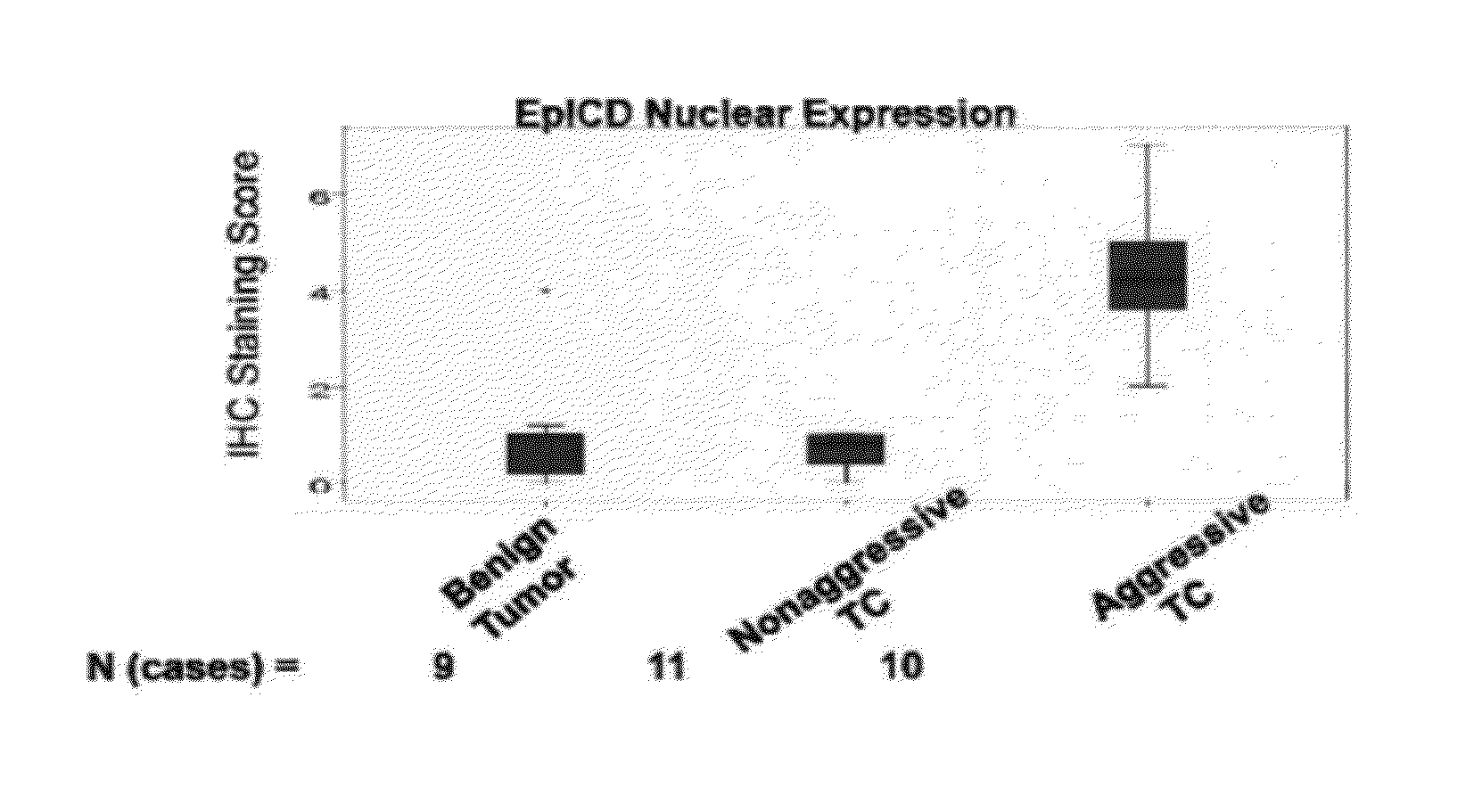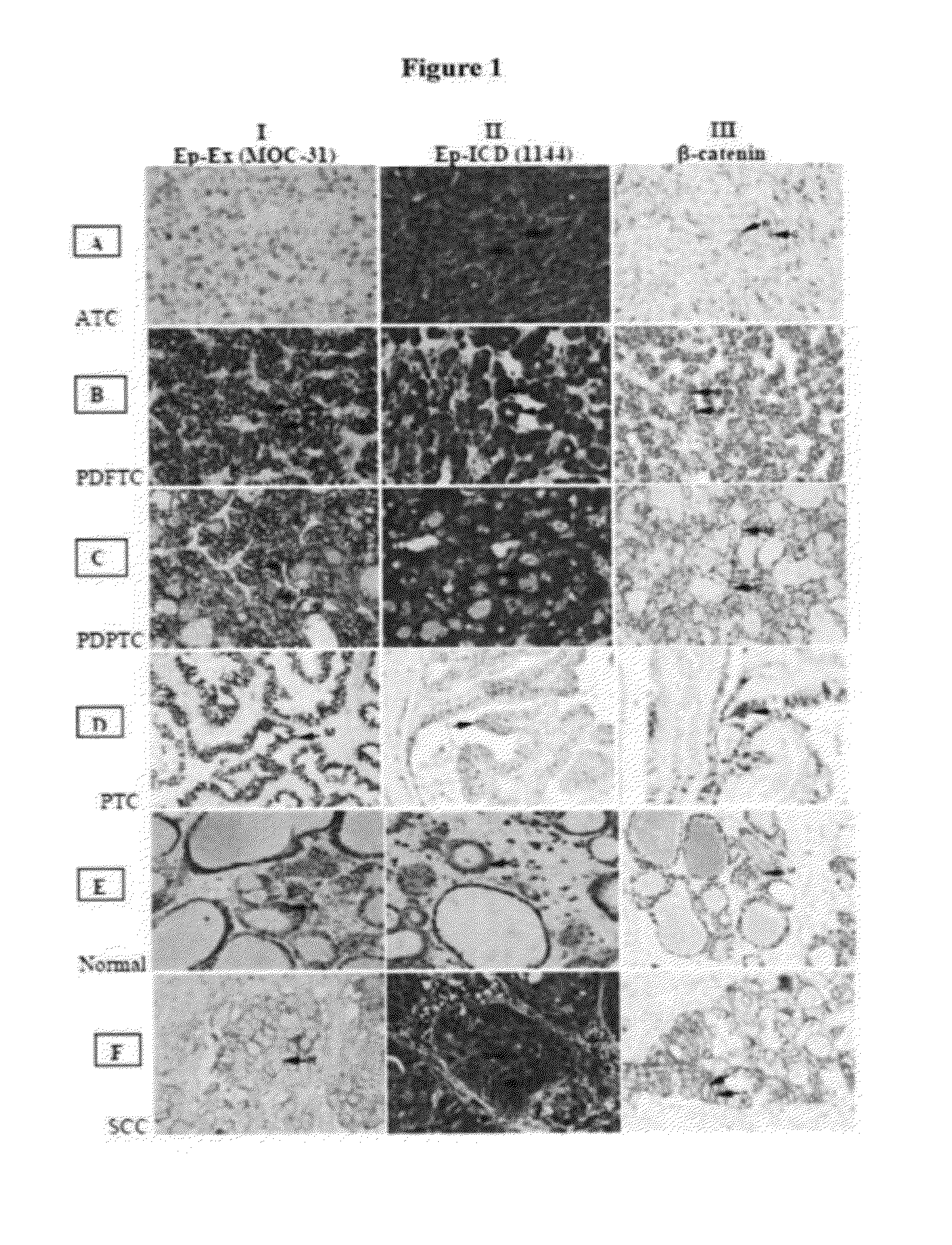Methods and Compositions for the Diagnosis and Treatment of Thyroid Cancer
a thyroid cancer and composition technology, applied in the field of thyroid cancer markers, can solve the problems of increased mortality, no proven predictive molecular markers to identify aggressive tcs, and less-differentiated thyroid tumors
- Summary
- Abstract
- Description
- Claims
- Application Information
AI Technical Summary
Benefits of technology
Problems solved by technology
Method used
Image
Examples
example 1
[0311]EpEx and Ep-ICD protein expression in primary human thyroid cancers as well as in a panel of aggressive and non-aggressive thyroid cancer cell lines and by immunohistochemistry (IHC) using antibodies directed against Ep-Ex and Ep-ICD domains of EpCAM were investigated and the findings confirmed by western blotting. To determine if EpCAM overexpression is attributed to increased transcription quantitative real time PCR (Q-PCR) was used for analysis of EpCAM transcripts in these tumors. Further, concurrent staining for nuclear Ep-ICD and β-catenin was carried out to establish the prognostic value of oncogenic Ep-ICD signaling in thyroid cancer.
[0312]The following materials and methods were employed in the Study described in this Example.
Materials and Methods
Patients and Tissue Specimens:
[0313]The study was approved by Ontario Ethics Committee and Mount Sinai Hospital, Toronto, Canada. All patients were informed and signed consent was obtained. Thirty thyroid carcinoma paraffin b...
example 2
EpCAM—Potential Therapeutic Target
[0350]Inhibition of EpCAM-Positive Thyroid Cancer Cell Proliferation Upon Treatment with VB4-845 / VB6-845
[0351]The effects of EpCAM-specific immunotoxin, VB4-845 / VB6-845, on cell proliferation were examined in the panel of thyroid cancer cell lines as well as in the positive control colon cancer cell line with different levels of EpCAM expression. As shown in the FIG. 7, the MTT based cell viability assay showed that VB4-845 inhibited proliferation of WRO and ARO cells, with IC50 of 1 pM and 0.7 pM, respectively. In comparison, the medullary thyroid cancer cell line, TT, was marginally responsive to the immunotoxin treatment, while the papillary cell line, TPC-1, and anaplastic cell line, CAL-62, with no detectable membrane EpCAM expression were non-responsive to VB4-845. Similar results were observed in the same cell lines treated with VB6-845 (data not shown).
Induction of Apoptosis by VB4-845 in Thyroid Cancer Cell Lines.
[0352]Cell cycle analysis o...
example 3
[0355]The following materials and methods were employed in the Study described in this Example.
Patients and Tissue Specimens:
[0356]The study was approved by Mount Sinai Hospital Research Ethics Board, Toronto, Canada. For IHC analysis, archived tissue blocks of normal thyroid tissues (N=9), Non-neoplastic-Hyperplastic / colloid nodules (N=1), papillary thyroid carcinoma (PTC, N=86), follicular thyroid carcinoma (FTC, N=2), poorly-differentiated PTC (N=1), poorly-differentiated FTC (N=1), medullary thyroid carcinoma (N=3), Insular carcinoma (N=6), SCC (N=4), anaplastic thyroid carcinoma (N=11) were retrieved from the tumor bank, reviewed by the pathologist and used for cutting tissue sections for immunostaining with Ep-ICD and EpEx (Moc31) antibodies as described below.
[0357]The following is a discussion of the results of the study.
Scatter Plot Analysis
[0358]The scatter plots in FIG. 10-14 illustrate the distribution of Ep-ICD and EpEx membrane / cytoplasmic / nuclear immunohistochemical s...
PUM
| Property | Measurement | Unit |
|---|---|---|
| median survival time | aaaaa | aaaaa |
| Tm | aaaaa | aaaaa |
| temperature | aaaaa | aaaaa |
Abstract
Description
Claims
Application Information
 Login to View More
Login to View More - R&D
- Intellectual Property
- Life Sciences
- Materials
- Tech Scout
- Unparalleled Data Quality
- Higher Quality Content
- 60% Fewer Hallucinations
Browse by: Latest US Patents, China's latest patents, Technical Efficacy Thesaurus, Application Domain, Technology Topic, Popular Technical Reports.
© 2025 PatSnap. All rights reserved.Legal|Privacy policy|Modern Slavery Act Transparency Statement|Sitemap|About US| Contact US: help@patsnap.com



